Yes, it's true - there is some climbing in Denmark. Most people think the whole country is as flat as a pancake... but... there are some Danish Islands, and one of them has some rock! What is the name of this saviour of Denmark? Bornholm.
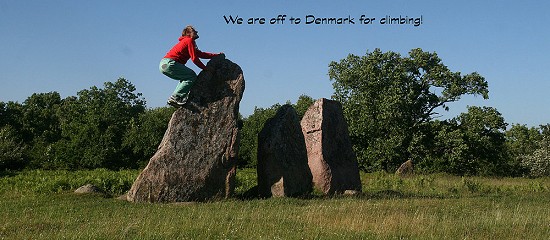
Currently, there are approximately 500 routes of differing character on the island and developments are still in their infancy so there is more to come. The climbing here ranges from bouldering, to route climbing on the north coast cliffs all the way to ascents in the disused and sometimes still active quarries. The longest (free-) route on the island is about 40 metres in length, so anyone expecting Bornholm to yield big wall climbing like the Alps or the Dolomites, will be disappointed. On the other hand those who can think in a smaller dimension and would like a relaxed climbing holiday might find pleasure on this little island.
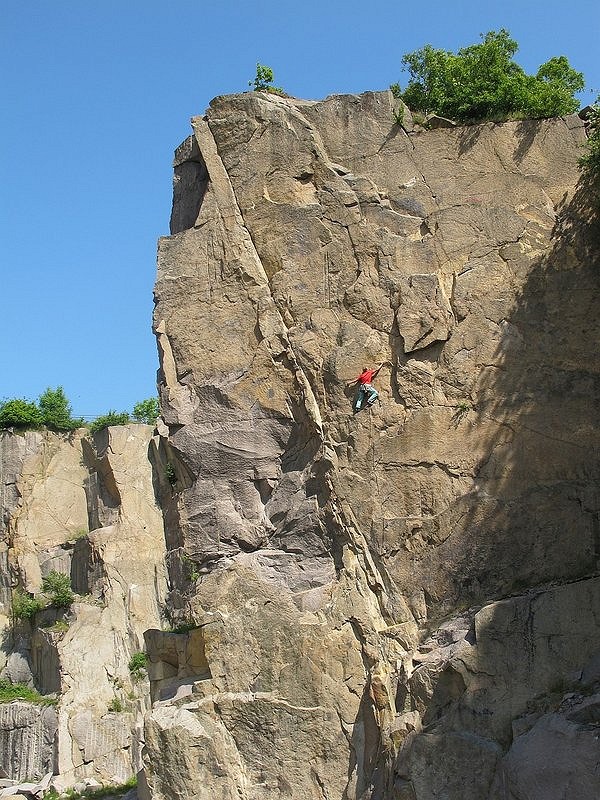
All the routes on natural cliffs are trad routes - no bolts. Occasionally, lower-offs can be found at the top of routes to get back down, otherwise it is necessary to build your own anchors. Some routes on the cliffs in the north-western coastal area finish on grassy slopes. In these cases finding a belay requires a fertile imagination, not dissimilar to some of the UK sea cliffs.
Bouldering is permitted on all of the island's existing boulders, cliffs and rocks.
Sport climbs have spread in recent years with most located in the quarries. In particular the Moseløkken Stenbrud quarry will appeal with its well-bolted routes. The Vangbruddet quarry is in the early stages of development and climbers must check whether the quarry is still in use or if there are any current climbing restrictions - signs are often displayed at the crags and, to be on the safe side, if possible only visit the quarries at weekends.
The Best Areas
The best aid climbing areas (yes - aid climbing!) are without doubt the cliffs of Vang syd (the island's biggest climbing area), the routes along the Randkløve Gorge and the Hammerbruddet quarry with its idyllic location near Opalsøen and Hammersøen. A must-visit is Denmark's only mountains: Krogeduren and Baily Tårnet.
Although still active, the quarry of Moseløkken is the most important and developed sport climbing area on Bornholm. It is an impressive showcase of the symbiosis between climbing as a sport and commercial use - climbing and quarrying together! All routes have moderately spaced resin bolts, with double bolted (or threaded sling and karabiner) lower-offs. The height of the wall ranges from 6 m to 35 m. Thus, for the longer routes, pack a 70 m rope. The quarry offers a varied potential of routes in all grades and styles. Be aware of loose rock and always wear a helmet. Away from the routes described are a number of (in parts) loose blocks.
This is the gateway to the Vang nord, Vang syd, Vangbruddet and Ringeladen climbing areas. For a number of years the (currently partially still active) quarry has undergone widespread changes for leisure activities. In summer 2011 a small artificial sandy beach and diving board were inaugurated on the Vang pier (the former quarry terminal) along with the chance to dive and fish.
The climbing area has some of the island´s best climbing routes on offer. The crag predominantly faces west so that it get the afternoon sun though it can sometimes get windy.
In the pier area there is a general parking ban. Parking is only permitted for the quarry workers. As the approach to the coastal cliffs is over granite blocks of differing sizes you should wear decent approach shoes.
Lænestolsvæggen is the best cliff in this area and absolutely worth a visit. It is composed from two cliffs separated by a block filled gorge. While the routes on the northern cliff offer easy climbing, on the southern cliff difficulty is the order to the day. The cliffs are so named as previously there was an armchair (Lænestol – translated literally 'lean stool') at the entrance.
The best routes at Lænestolsvæggen:
- *Blød Start
- **Diedren
- **Hurtigruten
- **Frafaldet
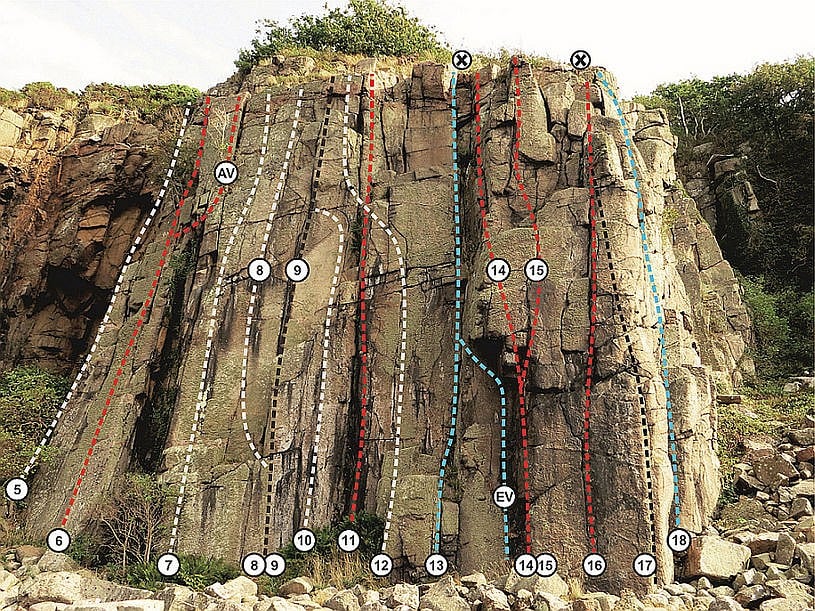
Approach
From road 159 (Borrelyngsvej) follow the signs to the village on the coast. Next to the small harbour is a car park. Vang car park coordinates: N55.24797, E014.73535.
Climbing Restrictions
Vang is a conservation area where climbing is permitted if nature is respected. On the coast there are many places where the uncommon Black Spleenwort fern grows. Further, the Rock Whitebeam grows in the rocks of these cliffs. The Helligsdomsklipperne and the coast of Vang are the only places in Denmark where this tree is to be found. These plants are therefore strictly protected. The southern part of the coast is especially well used in spring by many birds for breeding and one should be mindful of this. Amongst other things, a small number of auks (Alcidae) nest here.
Access
From the harbour in Vang walk past the pier, along the coast and a further 17 minutes south. Lænestolsvæggen is located approximately 300 m south of the junction into the quarry.
Coordinates: N55.24261, E014.72842
Halfway between Saltuna and Ypnested is an island attraction. Giant granite blocks form a 50 m long, five to six meter wide and 15m deep chasm. The cause of this ravine is a gulf that runs from northeast to southwest across the island and forms trenches.
Randkløve is the prettiest and most prolific climbing area on the whole north coast. In the gorge (Skåret) and its immediate surroundings there are a multitude of excellent routes on solid rock. North and south along the coast there are a number of short, easy routes that can be climbed or bouldered. In the Skovklipperne sector there are still occasionally fiechtl pegs to be found, which must stem from the initial period of development.
The walls face in all directions, although the routes in the Skåret (gorge) only manage to occasionally enjoy the sun. All routes are protected against a westerly wind.
The sectors Elses Væg and Heurekavæggen lie on both sides of the gorge and offer a large amount of midgrade routes (faces and cracks) between n4 and n7-. One peculiarity is found here, the Røde Mor is the only sport climb on a natural cliff on the island.
The best routes at Elses Væg:
- **Røde Mor
- ***Sorte Else
- **Hammerstart
- **Klemmelusen
The best routes at Heurekavæggen:
- ***Heureka
- **Victory
- *Rosenrids
- **Kwanka Wanka
Approach
On the coastal road (Gudhjem - Nexø, road 158) near the Risevej a side road to "Randkløvegård" (Randkløve court) branches off. Look out for the sign to "Randkløve". There is a large car park with toilets here.
From the car park follow follow a track for about 100 m in an easterly direction. Then turn left and walk along the edge of the woods on the bank of a small stream. Stick closely to the to the path around the field until a path leads off down to the water. The Randkløve Skåret is on the right hand side.
Coordinates Entrance Skåret (gorge): N55.17194 E015.04005
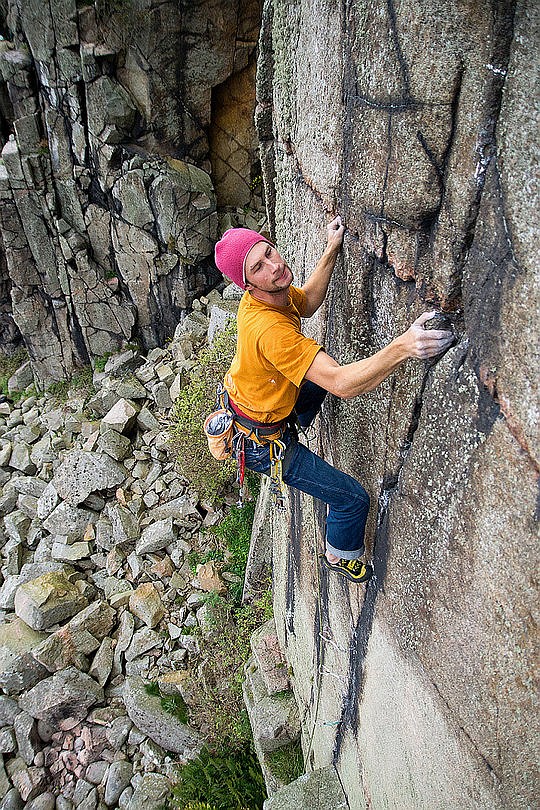
Climbing Restrictions
The area around Randkløve Skåret has been a nature conservation area since 1905. This, however, does not impose any restrictions with regards to climbing. In the description of the surroundings by the Ministry of Environment, excessive overgrowth is named as a threat to valued nature. It must then in everyone's interests to keep the crags free of growth by climbing them.
Randkløve Skåret is under the ownership of Torben Svendsen (Ellesgaard, Kirkebyvej 39, Østermarie, Tel. 56 47 01 44).
Moseløkken is one of the few areas on the island, where at times granite is still quarried. Although still active, Moseløkken is the most important and developed sport climbing area on Bornholm. It impressively evidences the symbiosis between climbing as a sport and commercial use. All routes have moderately spaced resin bolts, with double bolted (or threaded sling and karabiner) lower-offs. The height of the wall ranges from 6 m to 35 m. Thus, for the longer routes, pack a 70 m rope. The quarry offers a varied potential of routes in all grades and styles. Be aware of loose rock and always wear a helmet.
Approach
Drive towards Allinge. At the petrol station on the 159 road continue into the village and after 300 m left onto the Pilegade. After leaving the village the road joins the Moseløkkevej. At this crossroads keep left and follow the signs on the gravel road to the quarry museum, close to which sufficient parking possibilities are to be found. Please do not block the access roads.
Go past the quarry museum on the left, pass a small car park and follow the way until the entrance to the quarry. Through an "alley" formed by towering granite blocks the active quarry is reached. Please, under no circumstance, go over the slopes or blocks: danger of death!
Coordinates Quarry Museum: N55.27363, E014.77699
Climbing Restrictions
Warning: the quarry is active. Heavy machines are used and blasting takes place with dynamite. For this reason, climbing and other activities are not permitted on weekdays. On weekends and public holidays, climbing is allowed. Whoever enjoys climbing in quarries during the week, may try after home time (around 17:00) but please report and seek permission from a worker at the quarry museum first.
For the moment Moseløkken offers nearly 80 routes through the grades. The large wall of Sector Laustvæggen is waiting with some multipitch routes, whereby the individual pitches can be combined into different variations. With the exception of Sneakers here the routes are tricky.
The Wirevæggen is one of the highest sectors in the quarry. Here there are a handful of steep, difficult wall and crack climbs. This sector is suitable for those who estimate hard routes.
In contrast the Skolevæggen offers an interesting mix of easy and hard routes and is often used by instructors, hence it is also named "School Wall". The sun only comes in the late afternoon. It can be very windy.
DMM are also running a climbing festival on Bornholm between the 6th and the 9th of June, more details below and on the DMM Website
Logistics
When to Go
Occasionally Bornholm has been called "the Northern Ibiza". This is because of the pleasant and moderate maritime climate with relatively mild winters and cool summers. In the summertime it is sunnier and drier here than on the Danish mainland; in the wintertime it is milder, but also has more snow. Compared to the mainland, spring and autumn start ten days later on Bornholm. The primary cause for this is the slow warming up of the Baltic Sea, which also stores heat for longer in the late summer.
Bornholm's average precipitation varies from (only) 600 to 800 mm per year.
The best time to visit the island is from the end of June to September. The majority of tourists visit the island in July and August but even then, compared to other regions of the Baltic Sea, it is considerably less busy. After the school holidays have fi nished (end of August) the place becomes a haven of quietness and tranquility. One could also visit just for hiking or climbing from May to June, or September to October, however, one may well get more rain in the autumn.
How to Get There
The best approach to the island is by ferry. The crossing from Saßnitz (Rügen Island) takes around 3.5 hours. Starting from Ystad, Sweden, takes about 1 hour and 20 minutes. Journeys from Køge in the Danish motherland, last much longer (around 5.5 hours). The prices for a ferry from Saßnitz to Rønne vary seasonally from €116 to €234 per car and trip (prices for 2014). Cars must not carry more than five passengers. Passengers are not charged additionally. (see www.faergen.dk). One can also travel as foot passenger; with prices varying between €24 and €31.
The airport is located near the island's capital, Rønne. It is served by direct flights from Copenhagen several times a day (see www.bornholms-lufthavn.dk).
Where do I stay?
Those who like camping should have a look at the campsites in Balka, Hasle, Allinge, Dueodde and Rønne. Alternatively there are youth hostels, holiday apartments, holiday homes, B&Bs or hotel rooms of various size and amenities available. All major travel businesses offer a broad range of accommodation.
For some ideas have a look at Feriepartner Bornholm which provides a variety of holiday homes for every budget (www.feriepartner.com). Another site worth mentioning is Team Bornholm: www.teambornholm.dk. This latter provider offers not only a great number of holiday homes and apartments but also has B&Bs and camping huts.
Guidebooks
Bornholm on the Rocks Kletter-Reise-Führer Bornholm / Climbing / Travel Guide
Karsten Kurz
March 2014, 256 pages, lots of topos, shots and comics. Full coloured, ausführlicher Reiseführerteil! continuous bilingually (German and English)
ISBN 978-3-00-041341-4
Geoquest Verlag Halle (Saale); price: 25,00 Euro
You can buy the Bornholm guidebook HERE
Can I buy climbing gear?
There are no climbing shops on Bornholm so you will need to bring all your own gear with you.
A 60 meter rope is sufficient, alternatively, you could use twin ropes. A wide range of nuts and cams is required and having slings can be useful for belays and for abseiling too. A dozen quickdraws are needed for the sport routes in Moseløkken Stenbrud and Vangbruddet. No matter what type of climbing you are doing a helmet is advised: Especially in the quarries where is some loose rock you can be expect.
A wire brush is useful to remove the lichen that can build up and boulderers will need a pad. In most cases the landings are good but some of the problems have rocky bases. Aid climbers will need the usual specialist gear like bolts, rurps, birdbeaks and skyhooks. The use of chalk is allowed. A decent pair of approach shoes is also recommended.







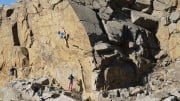






Comments